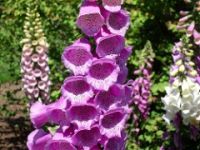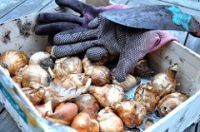A List of Some Common Poisonous Garden Plants

Poisonous Flowers & Leaves:
 Rhododendron – all parts of the rhododendron are extremely poisonous to humans (and dogs) and any part, flowers or leaves, if ingested, can lead to coma and death.
Rhododendron – all parts of the rhododendron are extremely poisonous to humans (and dogs) and any part, flowers or leaves, if ingested, can lead to coma and death.- Lily of the Valley – these pretty, sweet-smelling plants can cause severe problems with only a tiny bite and ingestion can, again, lead to coma and death.
- Hydrangea – this is another common garden plant that can be deadly. The poison is a cyanogenic glycoside which causes a drop in blood pressure and potentially convulsions and death.
 Foxglove – The entire plant can be deadly, especially the leaves high up on the stem. While digitalin, digitoxin and digitonin are used medicinally, ingesting the plant can cause extreme heart problems and even death if left untreated.
Foxglove – The entire plant can be deadly, especially the leaves high up on the stem. While digitalin, digitoxin and digitonin are used medicinally, ingesting the plant can cause extreme heart problems and even death if left untreated. - Larkspur – These flowers may be beautiful to look at but they are definitely not for eating. The entire plant contains toxic alkaloids though the young leaves and mature seeds are the most dangerous.
- Oleander – Nerium oleander can be extremely dangerous as it can serious harm and even kill with just a single leaf. The whole plant is poisonous, including the nectar and sap.
- Deadly Nightshade (and family) – While most people are aware of Belladonna or Deadly nightshade as a poisonous plant, few realise that some common food plants are in the same plant family. Potato and tomato foliage, for example, should never be eaten.
 Narcissus, Daffodils – While daffodil bulbs are not the most deadly of poisons, it seems they account for many accidental poisonings each year, most of which occur when people mistake the bulbs for onions.
Narcissus, Daffodils – While daffodil bulbs are not the most deadly of poisons, it seems they account for many accidental poisonings each year, most of which occur when people mistake the bulbs for onions. - Bluebell (Hyacinthoides) – Bluebells are also poisonous and can also resemble spring onions, which is the reason why they are accidentally eaten. Like daffodil bulbs, eating them can cause severe digestive upset.
- Mistletoe – All parts of mistletoe are poisonous but especially the berries. Ingestion can cause severe digestive problems which have even led to death in humans and can also be particularly of concern for pets.
- Laburnum – laburnum poisoning often occurs when kids mistake the unripe seed pods for peas or beans.
- Yew – All parts of the yew tree except the outer flesh of the berries are poisonous and can cause death without interceding symptoms within a few hours.
Remember, this is only a very incomplete list. Always teach children not to eat anything from the garden that you have not given them express permission to eat and take care to protect pets from danger.